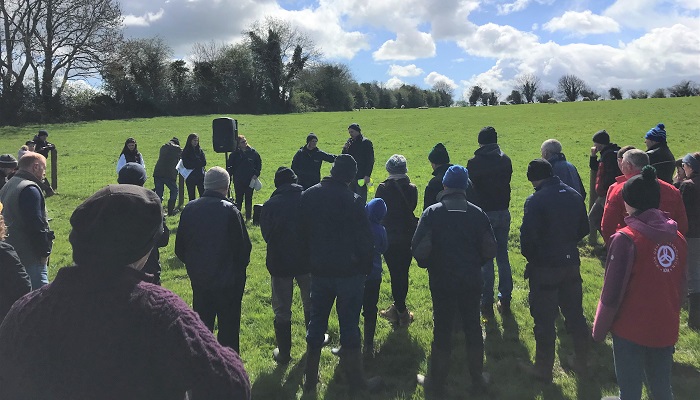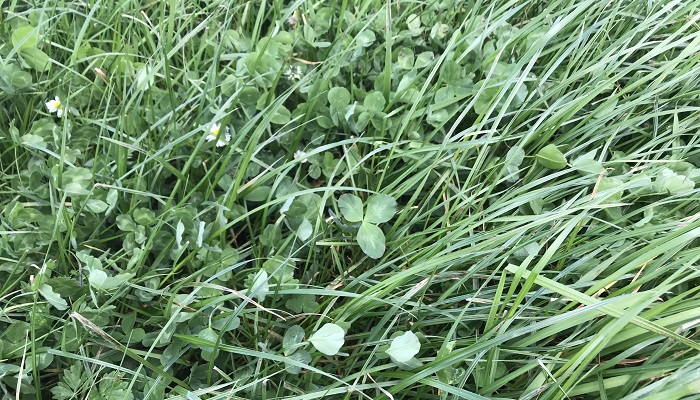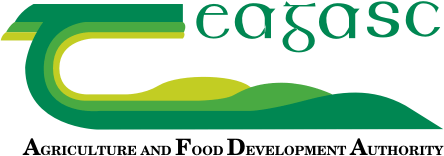23 April 2023
Summer decisions affect winter performance on organic farms

Although the differences between organic and conventional farming are numerous, one key aspect is central to both – the importance of silage quality.

The silage quantity versus quality debate is an annual occurrence on drystock farms, with many still favouring a heavy, bulky cut of silage – the quantity factor – in preference to the quality parameter.
At a recent Teagasc organic farm walk, held on the farm of Pierce Harte, Rathdowney, Co. Laois, Teagasc Organic Specialist Elaine Leavy discussed the importance of not only ensuring organic farms have sufficient silage reserves through the completion of a fodder budget, but also why excellent quality feed is required to support animal performance over the winter months.
“It is a balance between having quality and quantity,” Elaine explained, adding: “Farmers feel that they have to get a good bulk, aiming for one big cut, but sometimes that can be to the detriment of quality. For animals to perform in an organic situation, we really need to focus on silage quality and dry matter digestibility (DMD) is the benchmark of silage quality. The higher the DMD, the better the feed. With low silage quality, you are going to have to go in with extra concentrates.
“Supplementing is expensive in conventional farming, but it is twice as expensive in an organic situation; you really need to focus on silage quality.”
The cost of poor quality silage
Providing an example of what impact a ‘low’ quality silage can have on animal performance and financials of an organic farming system, Elaine compared the levels of performance achievable to those when ‘high’ quality silage is offered.
Table 1: Impact of feeding low versus high quality silage
| Silage quality | Low | High |
|---|---|---|
| Animal starting weight | 500kg | 500kg |
| Total gain required | 100kg | 100kg |
| Forage intake (kg) | 7.5 | 9.2 |
| Energy intake | 5.8 | 8.3 |
| Crude protein | 11.5 | 13.2 |
| Daily gain from forage (kg) | 0.40 | 0.85 |
| Days to finish | 200+ | 115 |
| Meal required to achieve equal weight gain | 4.0-4.5 | |
| Total meal cost/head (assumed €850/t organic ration) | €440 |
With a starting weight of 500kg, animals offered the low quality silage would require 200+ days of feeding without the addition of concentrates to achieve the same weight gain of those on a high quality silage. When concentrate is used to bridge the gap in performance, it represents an additional concentrate spend of approximately €440/head at an assumed organic certified concentrate price of €850/head. The differences in performance, outlined in table 1, occur due to the lower intake potential, energy density and protein content of low quality silage compared to high quality silage.
Producing high quality silage
Elaine pointed to the factors that contribute to achieving high quality silage under an organic farming system, adding: “The quality of silage is determined by the growth stage at harvest of your grass. The longer you leave it, the stemmier the grass will get and the quality of your silage is going to decrease. With silage quality, the number one factor is the time of cutting and leaf stage.”
Table 2: Causes of DMD drop in silage
| Causes | Size of % drop in DMD |
|---|---|
| One week delay in harvesting | 3 |
| Old pasture (little ryegrass) | 5 |
| Lodging | 9 |
| Not grazed (dead butt) | 7 |
| Bad preservation | 3 |
| Heating at feeding | 3 |
Securing quality winter feed supplies
Pierce Harte has been farming organically since 2011, operating a beef and sheep system on 250ac. The farming system consists of 200 lowland-bred ewes, while 70-80 Limousin and Charolais sired weanlings are purchased yearly and carried to beef at 26-28 months of age, with the aim of producing a 400kg carcass at slaughter.
For the coming winter, the farm will require 804 bales of silage. At the farm walk, Pierce explained how this will be achieved this year. 60ac of the farm has been closed for silage, consisting of a mixture of red clover and white clover swards. Three cuts will be targeted from the red clover / grass swards, which is expected to yield 540 bales from 30ac. Two cuts will be achieved from the white clover / grass swards, with the aim of producing 330 bales of silage from 30ac. With these combined harvests, Pierce expects the farm to produce 870 bales of silage. The first cut of red clover silage will be taken in May, with two more subsequent cuts to follow, before being grazed with lambs for the remainder of the year. The white clover swards will be cut in the first week of June, with one more cut taken, before being grazed.

To balance the off-takes from these silage harvests, Pierce uses cattle slurry and imported dairy sludge, which is permitted once the source is registered by the organic certifying body. The cattle slurry is applied in February at a rate of 3,500 gallons/ac, providing the crop with approximately 32 units of nitrogen/ac, 17.5 units of phosphorous/ac and 112 units of potassium/ac.
After the first cut, dairy sludge is then applied. The remainder of the sward’s nitrogen requirement comes from the clover plant’s ability to fix nitrogen from the atmosphere and covert it into a plant-utilisable form. Given this, these clover-based swards play a valuable role on the farm. To avoid the ingress of weeds and ensure future performance, regular reseeding is carried out using the plough-till-sow method. During crop establishment, farm yard manure is ploughed into the soil to further boost the soil’s P and K availability.
In DMD terms, this cutting programme produced excellent quality silage on the farm last year, with a DMD of 74.3% achieved.
Also read: Growing red clover silage to finish beef cattle
